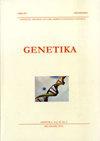Prevalence of variants in DFNB1 locus in Serbian patients with autosomal recessive non-syndromic hearing loss
4区 农林科学
Q3 Agricultural and Biological Sciences
引用次数: 0
Abstract
Hearing impairment is the most common sensorineural disorder in humans and many genes have been identified as causable. Despite genetic heterogeneity, a single locus, DFNB1, that contains genes GJB2 and GJB6, accounts for up to 50% of all cases. Aim of this study was to determine prevalence of identified variants in DFNB1 locus in patients from Serbia with autosomal recessive non-syndromic hearing loss (ARNSHL). In this study, PCR-ARMS and direct sequencing of the GJB2 and GJB6 genes was carried out in 54 probands and relatives from Serbia with nonsyndromic hearing loss (NSHL). In 31 patients a series of variants have been identified in the GJB2 gene. Fully characterized genotype with bi-allelic mutations was observed in 40.74% of the probands (22/54). The remaining probands were either identified in the heterozygote form (9/54) or were identified with no (23/54) causing variants for the tested genes. A total of seven different mutations were found with following allele frequencies: c.35delG (31.48%), c.71G>A (6.48%), c.313_326del (5.56%), c.101T>C (1.85%), c.380G>A (1.85%), c.79G>A (0.92%) and c.269T>C (0.92%). The molecular basis of NSHL in patients from Serbia was analyzed for the first time in this study. The results have important implication to the development of the genetic diagnosis of deafness, genetic counseling, and early treatment in our country. Also, our findings contribute to the knowledge of geographic distribution of DFNB1 mutations.塞尔维亚常染色体隐性非综合征性听力损失患者DFNB1基因座变异的流行
听力障碍是人类最常见的感觉神经障碍,许多基因已被确定为病因。尽管存在遗传异质性,但包含GJB2和GJB6基因的单一位点DFNB1占所有病例的50%。本研究的目的是确定塞尔维亚常染色体隐性非综合征性听力损失(ARNSHL)患者中DFNB1位点已识别变异的患病率。本研究对54名塞尔维亚非综合征性听力损失(NSHL)患者的先证者和亲属进行了GJB2和GJB6基因的PCR-ARMS和直接测序。在31例患者中,已鉴定出GJB2基因的一系列变体。40.74%的先证者(22/54)具有双等位基因突变的完全特征基因型。其余先证者要么为杂合子形式(9/54),要么为无变异(23/54)。共发现7个不同的突变,等位基因频率分别为C . 35delg(31.48%)、C . 71g >A(6.48%)、C .313_326del(5.56%)、C . 101t >C(1.85%)、C . 380g >A(1.85%)、C . 79g >A(0.92%)和C . 269t >C(0.92%)。本研究首次分析了塞尔维亚NSHL患者的分子基础。研究结果对我国耳聋的遗传诊断、遗传咨询和早期治疗具有重要意义。此外,我们的发现有助于了解DFNB1突变的地理分布。
本文章由计算机程序翻译,如有差异,请以英文原文为准。
求助全文
约1分钟内获得全文
求助全文
来源期刊

Genetika-Belgrade
AGRONOMY-GENETICS & HEREDITY
CiteScore
1.80
自引率
0.00%
发文量
1
审稿时长
6-12 weeks
期刊介绍:
The GENETIKA is dedicated to genetic studies of all organisms including genetics of microorganisms, plant genetics, animal genetics, human genetics, molecular genetics, genomics, functional genomics, plant and animal breeding, population and evolutionary genetics, mutagenesis and genotoxicology and biotechnology.
 求助内容:
求助内容: 应助结果提醒方式:
应助结果提醒方式:


